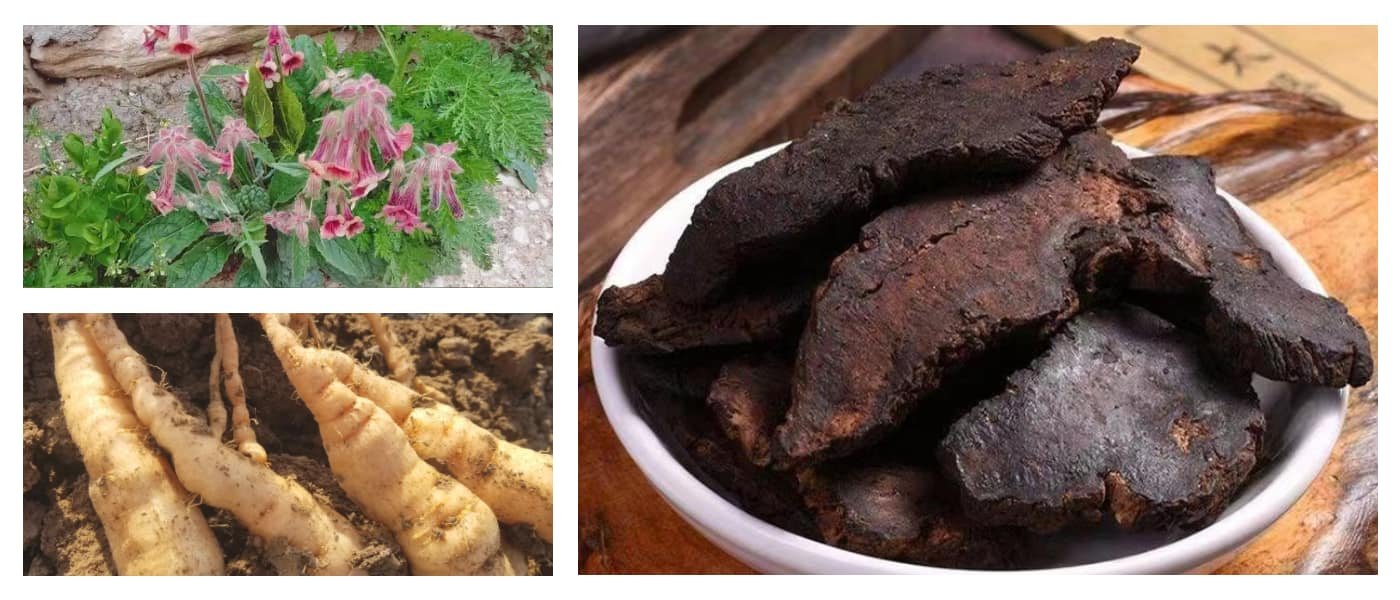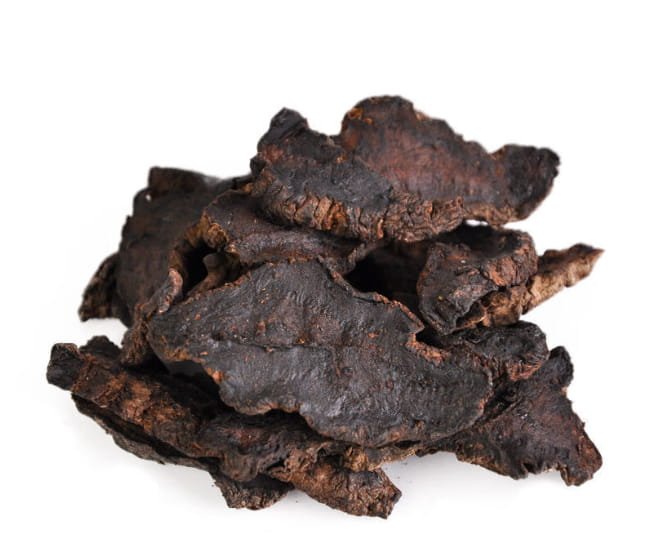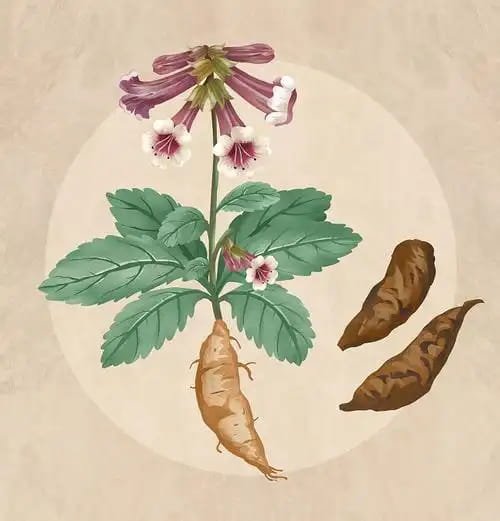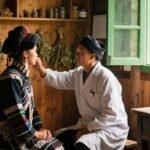Raw Rehmannia Root (Sheng Di Huang)

What Is Raw Rehmannia Root (Sheng Di Huang)?
Raw Rehmannia Root (Sheng Di Huang) refers to the fresh or dried tuberous root of Rehmannia glutinosa Libosch., a plant belonging to the Scrophulariaceae family.
Nature and Flavor: Sweet and Bitter, Cold
Meridian Affiliation: Heart, Liver, and Kidney Meridians
It is commonly used in Traditional Chinese Medicine (TCM) for its functions in clearing heat, cooling the blood, nourishing yin, and generating body fluids. It is mainly indicated for:
- Heat invading the nutrient and blood systems, red tongue with thirst, rashes, vomiting of blood, or nosebleeds
- Yin deficiency with internal heat, low-grade tidal fevers, or steaming bone disorder
- Damage to body fluids causing thirst, internal heat-related diabetes, or constipation due to intestinal dryness
What Are the Benefits of Raw Rehmannia Root (Sheng Di Huang)?
Traditional Uses
Raw Rehmannia Root (Sheng Di Huang) clears heat and cools blood, nourishes yin, and generates fluids.
- For febrile diseases affecting the blood level, symptoms like crimson tongue, irritability, thirst, rashes, or bleeding:
This herb, being bitter, cold, and entering the blood system, is a key medicine for cooling the blood and stopping bleeding. Its sweet and moist nature also makes it effective for relieving thirst and generating fluids. - For yin deficiency with internal heat and steaming bone disorder:
Its sweet-cold character nourishes yin, while its bitter-cold quality purges fire. It enters the Kidney meridian to nourish yin and reduce internal heat. - For thirst due to fluid deficiency, internal heat diabetes, or constipation from intestinal dryness:
With its moistening nature, it clears heat, nourishes yin, and relieves dryness-induced thirst and dryness-related constipation.
Modern Pharmacological Effects
- Water extracts of Raw Rehmannia Root (Sheng Di Huang) show effects such as lowering blood pressure, calming the nervous system, anti-inflammatory, and anti-allergic properties.
- Its fluid extract demonstrates cardiotonic and diuretic effects.
- The ethanol extract helps shorten clotting time, thus enhancing hemostatic function.
- It has been shown to counteract the suppression of plasma corticosterone caused by prolonged dexamethasone use and to (helps maintain) adrenal atrophy.
- It can promote lymphoblast transformation and increase T lymphocyte counts.
- It enhances the phagocytic activity of reticuloendothelial cells, especially in individuals with weakened immunity.
How to Use Raw Rehmannia Root (Sheng Di Huang)
Internal Use:
– Decoction: 10–15g
– Fresh root can be used at double the dose or crushed into juice for medicinal use

Precautions and Side Effects
Herbal Incompatibilities
Incompatible with Chuan Wu (Aconitum) and Cao Niao.
Dietary Avoidance
Avoid warm or spicy foods; do not consume with blood products, radish, onion, or garlic.
Usage Warnings
- Due to its cloying and moist nature, Raw Rehmannia Root (Sheng Di Huang) nourishes yin and enriches blood, but may harm spleen yang and hinder digestion. Therefore, it is not recommended for patients with weak spleen and stomach function, especially those with:
- Poor appetite
- Abdominal distension or loose stools
- Pale tongue with moist white coating
- Weak or thin pulse
- Since both yin herbs and damp pathogens are yin in nature, combining the two may cause internal damp stagnation. Not suitable for individuals with:
- Fullness or distension in the chest or abdomen
- Belching, gas retention
- Low appetite with thick greasy tongue coating
- In patients with damp-phlegm conditions due to yang deficiency of the Lung, Spleen, or Kidney, Raw Rehmannia Root (Sheng Di Huang) may worsen symptoms, such as:
- Phlegm accumulation
- Vomiting of clear fluid
- Shortness of breath, chest oppression
- Bloating, edema, obesity
- Gurgling intestines, coughing with breathing difficulty
As noted in Essentials of Medicine (Yi Xue Ru Men):
“Prohibited for those with cold in the middle jiao and symptoms like abdominal masses or loose stools.”
References on Rehmannia glutinosa (Raw Rehmannia Root)
Phytochemistry and Constituents
1. Ru-Xue Zhang, Mao-Xing Li, Zheng-Ping Jia. Rehmannia glutinosa: review of botany, chemistry and pharmacology. J. Ethnopharmacol. 2008;117(2):199–214.
View Article
2. Penghua Shu, Shujing Cai, Xiaojian Zhao, et al. Chemical Constituents from the Roots of Rehmannia glutinosa. Rec. Nat. Prod. 2023;17(4):615–621.
View Article
3. Wei Liu, Dong-Xue Yin, Tong Zhang, et al. Phytochemical Profiles and Antioxidant Activity of Rehmannia glutinosa from Different Production Locations. Chem. Biodivers. 2020;17(8):e2000341.
View Article
4. Hwaryeong Lee, Isoo Youn, Sang Gyun Noh, et al. Identification of Bioactive Compounds from the Roots of Rehmannia glutinosa and Their In Silico and In Vitro AMPK Activation Potential. Molecules 2024;29(24):6009.
View Article
5. Yan-Fei Liu, Dong Liang, Huan Luo, et al. Hepatoprotective iridoid glycosides from the roots of Rehmannia glutinosa. J. Nat. Prod. 2012;75(9):1625–1631.
View Article
6. Yan-Fei Liu, Dong Liang, Huan Luo, et al. Ionone glycosides from the roots of Rehmannia glutinosa. J. Asian Nat. Prod. Res. 2014;16(1):11–19.
View Article
7. Yan-Fei Liu, Wan-Qi Zhang, Jie Zhou, et al. Four new iridoid glycosides from the roots of Rehmannia glutinosa. J. Asian Nat. Prod. Res. 2024;26(3):293–301.
View Article
8. Xiao-Ke Zheng, Wei-Sheng Feng. Ionones and lignans from the fresh roots of Rehmannia glutinosa. Phytochemistry 2022;203:113423.
View Article
9. Huu-Tung Nguyen, Thi-Ngan Dan, Takuhiro Uto, et al. Phytochemical profile of the aerial parts of Rehmannia glutinosa Liboschitz var. purpurea Makino. Pharmacogn. Mag. 2020;16(67):128–131.
View Article
10. Ming-Kai Lu, Chia-Chieh Chang, Ching-Hsien Chao, Yu-Chen Hsu. Structural changes and anti-inflammatory, anti-cancer potential of polysaccharides from multiple processing of Rehmannia glutinosa. Int. J. Biol. Macromol. 2022;206:621–632.
View Article
Pharmacology and Bioactivities
1. Jinhao Jia, Jianfei Chen, Guoli Wang, et al. Progress of research into the pharmacological effect and clinical application of the traditional Chinese medicine Rehmanniae Radix. Biomed. Pharmacother. 2023;168:115809.
View Article
2. Yung-Hyun Choi. Catalpol from Rehmannia glutinosa targets Nrf2/NF-κB signaling pathway to improve renal anemia and fibrosis. Am. J. Chin. Med. 2024;52(5):1451–1470.
View Article
3. Gui-Hyun Baek, Yong-Suk Jang, Seung-Il Jeong, et al. Rehmannia glutinosa suppresses inflammatory responses elicited by advanced glycation end products. Inflammation 2012;35(4):1232–1241.
View Article
4. Li Xu, Wei Zhang, Ling Zeng, Jun-O Jin. Rehmannia glutinosa polysaccharide induced an anti-cancer effect by activating natural killer cells. Int. J. Biol. Macromol. 2017;105(Pt 1):680–685.
View Article
5. Bombi Lee, Insop Shim, Hyejung Lee, Dae-Hyun Hahm. Rehmannia glutinosa ameliorates scopolamine-induced learning and memory impairment in rats. J. Microbiol. Biotechnol. 2011;21(8):874–883.
View Article
6. Min-Kyung Kwak, Kyungmin Yu, Po-Chul Lee, Jin O. Jin. Rehmannia glutinosa polysaccharide functions as a mucosal adjuvant to induce dendritic cell activation in mediastinal lymph node. Int. J. Biol. Macromol. 2018;120(Pt B):1618–1623.
View Article
7. Zhiying Bian, Rui Zhang, Xin Zhang, et al. Extraction, structure and bioactivities of polysaccharides from Rehmannia glutinosa: A review. J. Ethnopharmacol. 2023;305:116132.
View Article
8. Chen Fu, Yifan Wu, Shaojiao Liu, et al. Rehmannioside A improves cognitive impairment and alleviates ferroptosis via activating PI3K/AKT/Nrf2 and SLC7A11/GPX4 signaling pathway after ischemia. J. Ethnopharmacol. 2022;289:115021.
View Article
9. Mengmeng Wang, Yingying Ke, Yage Li, et al. Nephroprotective effects and mechanisms of rehmapicrogenin include ROS inhibition via an oestrogen-like pathway both in vivo and in vitro. Biomed. Pharmacother. 2021;138:111305.
View Article
10. Chun-Song Cheon, Cheol-Hong Kim. Rehmannia glutinosa pharmacopuncture solution regulates functional activation, FcεRI expression, and signaling events in mast cells. J. Pharmacopuncture 2013;16(4):11–18.
View Article
Clinical and Applied Studies
1. Shalini Srivastava, Shu Fen Huang, Manjiri S. Jagtap. Assessment of the Effect of Rehmannia glutinosa Leaf Extract in Maintaining Skin Health: A Proof-of-Concept, Double-Blind, Randomized, Placebo-Controlled Clinical Trial. Clin. Cosmet. Investig. Dermatol. 2024;17:863–875.
View Article
2. Seok-hee Kim, Tae-han Yook, Jong-uk Kim. Rehmanniae Radix, an Effective Treatment for Patients with Various Inflammatory and Metabolic Diseases: Results from a Review of Korean Publications. J. Pharmacopuncture 2017;20(2):81–88.
View Article
3. Misato Ota, Junko Nakazaki, Yoshiaki Tabuchi, Takahiko Ono, Toshiaki Makino. Historical and pharmacological studies on rehmannia root processing – Trends in usage and comparison of the immunostimulatory effects of its products with or without steam processing and pretreatment with liquor. J. Ethnopharmacol. 2019;242:112059.
View Article
4. Ling Wang, Jin-Hui Zhu, Xiao-Dan Jiang, Zhen-Xiang Ma, Jin-Hua Tao. Preventive effects of the Rehmannia glutinosa Libosch and Cornus officinalis Sieb herb couple on chronic kidney disease rats via modulating the intestinal microbiota and enhancing the intestinal barrier. Front. Pharmacol. 2022;13:942032.
View Article
5. Yuping Chen, Siyuan Song, Anmei Shu, et al. The Herb Pair Radix Rehmanniae and Cornus Officinalis Attenuated Testicular Damage in Mice With Diabetes Mellitus Through Butyric Acid/GLP-1/GLP-1 Receptor Pathway Mediated by Gut Microbiota. Front. Microbiol. 2022;13:831881.
View Article
6. Ning Li, Yanru Yao, Erhui An. Clinical Efficacy of Bolus of Six Drugs Including Rehmannia as an Adjunct to Metformin in the Treatment of Senile Type-2 Diabetes Mellitus and its Influence on Insulin Resistance, Inflammatory Factors and Blood Glucose-related Indicators. Pak. J. Med. Sci. 2023;39(5):1429–1433.
View Article
7. Young-Joo Kim, Chang-Hyun Lee, Jong-Uk Kim, Tae-Han Yook. Effects of distilled Cervi Pantotrichum Cornu and Rehmannia glutinosa pharmacopuncture at GB21 (Jianjing) on heart rate variability: A randomized and double-blind clinical trial. J. Acupunct. Meridian Stud. 2016;9(6):311–318.
View Article
8. Lan Lin, Guang Yang, Xuefeng Zheng, Qiuhong Wang, et al. Liuwei Dihuang Pills Enhance the Effect of Western Medicine in Treating Diabetic Nephropathy: A Meta-Analysis of Randomized Controlled Trials. Evid. Based Complement. Alternat. Med. 2016;2016:6503184.
View Article
9. Tae-han Yook, Jungsuk Yu, Hwiyong Lee, et al. Comparing the effects of distilled Rehmannia glutinosa, wild Ginseng and Astragali Radix pharmacopuncture with heart rate variability (HRV): a randomized, sham-controlled and double-blind clinical trial. J. Acupunct. Meridian Stud. 2009;2(3):239–247.
View Article
10. D. Wook Lim, Y. Tai Kim. Dried root of Rehmannia glutinosa prevents bone loss in ovariectomized rats. Molecules 2013;18(5):5804–5813.
View Article
Chinese Pharmacopoeia (Zhong Guo Yao Dian): Sheng Di Huang

Other Names
Di Huang, Wild Rehmannia, Wine Pot Flower, Mountain Smoke Root
Source
The fresh or dried tuberous root of Rehmannia glutinosa Libosch., a plant of the Scrophulariaceae family. It is harvested in autumn. After removing the stem base, fibrous roots, and soil, it is either used fresh or slowly baked until about 80% dry. The fresh version is commonly referred to as “Fresh Rehmannia Root,” while the baked version is called Raw Rehmannia Root (Sheng Di Huang).
This herb is known for its ability to clear heat and cool the blood, nourish yin, and generate body fluids. It is traditionally used to treat conditions such as heat entering the nutrient and blood levels, dark-red tongue with restlessness and thirst, rashes, bleeding disorders, yin deficiency with internal heat, tidal fever due to chronic conditions, thirst from fluid injury, internal heat causing excessive thirst, and dry intestines with constipation.
Botanical Characteristics
A perennial, erect herbaceous plant, standing 10–30 cm tall, covered with dense white glandular hairs. The roots are fleshy. Leaves grow in a basal rosette, obovate-lanceolate in shape, narrowing at the base into a petiole, with irregular blunt serrations on the margin, wrinkled on the upper surface, and purplish on the underside. Flower stalks emerge from the leaf base, forming racemes. Calyx has five shallow lobes; stems are purplish-red. Basal leaves are ovate to long-elliptic with serrated edges. Terminal racemes bear tubular calyxes with five sepals. Corolla is purplish-red, about 4 cm long, two-lipped with five lobes, hairy on both sides. It flowers from April to May and fruits from July to August. Capsules are ovate to long-ovate, containing tiny seeds.
Geographic Distribution
Primarily produced in Henan, Hebei, Inner Mongolia, and Northeast China. Widely cultivated across many regions of China.
Identification of Medicinal Material
Herbal Characteristics
Usually irregularly block-shaped or oblong, with a swollen middle and slightly tapered ends, measuring 6–12 cm long and 3–6 cm in diameter. Some are slender and slightly twisted. The surface appears grayish-black or brownish-gray with heavy wrinkling and irregular transverse grooves. The herb is heavy, soft yet tough, with a cross-section that is gray-black, brown-black, or dark black, slightly shiny, and sticky. Mild aroma with a slightly sweet taste.
Prepared Slices
- Raw Rehmannia Root (Sheng Di Huang): Irregularly shaped slices of varying size and thickness. The cross-section appears brown-black or dark black with luster and stickiness. The outer surface is brown-black or brown-gray and wrinkled. The texture is soft and pliable, not easily broken. Odorless, with a slightly sweet taste.
- Charred Raw Rehmannia Root (Sheng Di Tan): Appearance similar to raw slices, but surface is brown-black or dark black with blistered, puffed texture due to charring.
Harvest and Processing
Harvested in autumn. After removing the stem base, fibrous roots, and soil, the roots are slowly baked until 80% dry.
Processing Methods
- Raw Rehmannia Root (Sheng Di Huang): Remove impurities from the crude herb, wash clean, slightly moisten, slice into thick pieces, and dry. Sift out fine particles.
- Charred Raw Rehmannia Root (Sheng Di Tan): Use cleaned slices of raw Rehmannia and process using the charring method (see Appendix I), frying until blistered and puffed.
Storage
Store in a dry, well-ventilated place. Protect from mold and insects.
Meridian Affiliation
Heart, Liver, Kidney
Nature and Flavor
Fresh Rehmannia: sweet, bitter, and cold
Raw Rehmannia: sweet and cold
Functions
Clears heat and cools the blood; nourishes yin and generates fluids.
Indications
- Heat entering the nutrient and blood levels, with symptoms like dark-red tongue, restlessness, thirst, rashes, and bleeding disorders: This herb, being bitter and cold, enters the nutrient and blood systems. It is essential for clearing heat, cooling the blood, and stopping bleeding. Due to its sweet and cold, moist nature, it also clears heat and generates fluids, relieving thirst.
- Yin deficiency with internal heat or tidal fever: The sweet and cold nature of the herb nourishes yin, while its bitter and cold quality purges heat. By entering the kidney meridian, it nourishes yin and reduces fire; it also promotes yin and fluids, helping release hidden heat.
- Thirst from fluid injury, internal heat causing excessive thirst, and dry intestines with constipation: Its sweet and cold, moist nature allows it to clear heat, nourish yin, generate fluids, and stop thirst.
Usage and Dosage
For internal use: decoction, 10–15g. The dosage should be doubled when using the fresh form, or juice can be extracted from the fresh herb for medicinal use.
Contraindications
- Incompatibilities with other herbs: Avoid combining with Chuan Wu and Cao Niao.
- Dietary precautions: Avoid warm and hot foods; abstain from consuming blood, radish, scallions, and garlic.
Precautions
- Due to its rich, cloying nature, Raw Rehmannia Root (Sheng Di Huang) nourishes yin and blood effectively, but it can damage spleen yang and hinder digestive functions. Therefore, those with spleen and stomach qi deficiency or spleen yang deficiency, manifesting as poor appetite, loose stools, abdominal fullness, and fatigue, should avoid using fresh or raw Rehmannia to (helps maintain) further harming yang and overburdening the spleen.
- The herb is yin in nature, and dampness is also considered yin. Using this herb in cases of dampness can lead to accumulation of cold and dampness, especially in the middle jiao (digestive system). Symptoms like chest and abdominal distention, belching, bloating, reduced appetite, dry mouth with minimal thirst, and thick greasy tongue coating indicate that this herb should be avoided.
- Accumulated fluids turning into phlegm, or phlegm and dampness arising from yang deficiency of the lung, spleen, and kidney may be worsened by this herb. Raw Rehmannia Root (Sheng Di Huang), being cold and yin, may suppress yang and lead to the development of phlegm and fluid accumulation. In such cases — including vomiting of clear fluid, shortness of breath, chest congestion, swelling and pain in limbs, obesity, cough with wheezing, and abdominal gurgling sounds — the herb should be used with caution.
Introduction to Medicine (Yi Xue Ru Men): “It is contraindicated for those with internal cold, abdominal distention, and loose stools.”
Chemical Constituents
This herb contains catalpol, dihydrocatalpol, melittoside, acetylcatalpol, aucubin, rehmannioside, rehmaglutoside, deacetylogenoside, picroside, capric acid, benzoic acid, phenylacetic acid, glucose, sucrose, fructose, and more than 20 trace elements including iron, zinc, manganese, and chromium. It also contains β-sitosterol. Fresh Raw Rehmannia Root (Sheng Di Huang) contains more than 20 types of amino acids, with arginine being the most abundant. The dried herb contains 15 amino acids, with alanine as the highest.
Pharmacological Effects
The aqueous extract of this herb has hypotensive, sedative, anti-inflammatory, and anti-allergic effects. Its tincture shows cardiotonic and diuretic properties. The ethanol extract shortens clotting time. Raw Rehmannia Root (Sheng Di Huang) can counteract the decline in plasma corticosterone levels caused by long-term dexamethasone administration, and it prevents adrenal cortex atrophy. It also promotes lymphoblast transformation, increases T lymphocyte count, and enhances the phagocytic activity of reticuloendothelial cells, with more pronounced effects in individuals with weakened immune function.
Clinical Applications
- For warm diseases with heat entering the nutrient and blood levels, manifesting as high fever, irritability, delirium, and dark-red tongue, it is often combined with herbs such as Figwort Root (Xuan Shen), Weeping Forsythia (Lian Qiao), and Red Sage Root (Dan Shen), as in Qing Ying Tang (from Discussion of Warm Diseases (Wen Bing Tiao Bian)).For bleeding due to blood heat, it is often used with Rhubarb (Da Huang), as in Da Huang San (from Comprehensive Discussion of Cold Damage Disorders (Shang Han Zong Bing Lun)).For bloody stool or hematuria due to blood heat, it is used with Sanguisorba Root (Di Yu), as in Liang Di Dan (from Secret Record of the Stone Room (Shi Shi Mi Lu)).For heavy postpartum bleeding or metrorrhagia accompanied by restlessness, it is combined with Motherwort (Yi Mu Cao), as in Di Huang Jiu (from Formulary of the Sacred Benevolence (Sheng Hui Fang)).
- For yin deficiency with internal heat and tidal fever, it is combined with Anemarrhena Rhizome (Zhi Mu) and Lycium Bark (Di Gu Pi), as in Di Huang Gao (from Medical Synthesis from Ancient to Modern Times (Gu Jin Yi Tong)).When combined with Sweet Wormwood (Qing Hao), Turtle Shell (Bie Jia), and Anemarrhena Rhizome (Zhi Mu), it treats residual heat and yin deficiency in late-stage febrile diseases, as in Qing Hao Bie Jia Tang (from Discussion of Warm Diseases (Wen Bing Tiao Bian)).
- For heat-related fluid injury with thirst, it is used with Ophiopogon Root (Mai Dong), Adenophora Root (Sha Shen), and Polygonatum Root (Yu Zhu), as in Yi Wei Tang (from Discussion of Warm Diseases (Wen Bing Tiao Bian)).For diabetes-type thirst syndrome, it is combined with Chinese Yam (Shan Yao), Astragalus Root (Huang Qi), and Asiatic Cornelian Cherry Fruit (Shan Zhu Yu), as in Zi Sui Yin (from Western-Inspired Records of Traditional Chinese Medicine (Yi Xue Zhong Zhong Can Xi Lu)).For constipation due to fluid depletion, it is used with Figwort Root (Xuan Shen) and Ophiopogon Root (Mai Dong), as in Zeng Ye Tang (from Discussion of Warm Diseases (Wen Bing Tiao Bian)).
Compound Prescriptions
- Raw Rehmannia Root (Sheng Di Huang) + Tree Peony Bark (Mu Dan Pi): nourish yin, cool blood, dispel heat, and remove stasis. This pair is suitable for symptoms like bleeding from yin deficiency and blood heat, or lingering heat in febrile disease recovery stages.
- Raw Rehmannia Root (Sheng Di Huang) + Prepared Rehmannia Root (Shu Di Huang): the cold-natured raw form clears heat and cools blood, while the warm-natured prepared form nourishes blood and essence. Together, they expand (used in traditional contexts) scope—used for postpartum symptoms, excessive menstruation, yin and blood deficiency, and elderly constipation.
- Raw Rehmannia Root (Sheng Di Huang) + Figwort Root (Xuan Shen): both clear heat and cool blood. Raw Rehmannia focuses on stopping bleeding, Xuan Shen on detoxifying. Ideal for various heat and yin deficiency syndromes including bleeding, throat swelling, and thirst.
- Raw Rehmannia Root (Sheng Di Huang) + Mume Fruit (Wu Mei): clears internal heat and restrains deficiency fire. Suitable for thirst and fever due to yin deficiency or summer heat.
- Raw Rehmannia Root (Sheng Di Huang) + Eclipta (Han Lian Cao): enhances blood-cooling and kidney-nourishing functions. Useful for hemoptysis and bleeding due to blood heat.
Commentaries from Classical Texts
- Divine Farmer’s Classic of Materia Medica (Shen Nong Ben Cao Jing): “Treats trauma and fractures, damage to muscles and tendons, blood stasis, nourishes bone marrow and promotes muscle growth. Decoction dispels cold and heat accumulations and eliminates painful obstruction. Fresh ones are particularly effective.”
- Supplement to the Classic of Materia Medica (Ben Jing Feng Yuan): “Dried Rehmannia is used internally to cool the blood and nourish yin, and externally to moisten and beautify the skin. It is suitable for patients who are weak and have heat symptoms. Dai Yuanli said: When yin is weak and yang is strong, ministerial fire becomes excessive and invades the yin, gradually consuming it. Use Raw Rehmannia Root (Sheng Di Huang) to nourish yin and suppress yang. Rehmannia from Zhejiang province excels in cooling blood and moistening dryness. For patients with weak vital qi and heat stagnation causing a dry, dark, or burnt tongue and constipation that cannot tolerate purging, this herb is best used within heat-clearing formulas, as it can gently relieve dryness without causing cloying or greasy side effects.”
The information provided on this page regarding traditional Chinese medicinal herbs is for educational and informational purposes only. It is not intended as medical advice, diagnosis, or (used in traditional contexts).



Leave a Reply